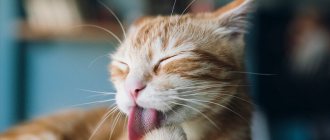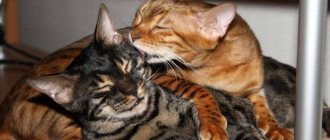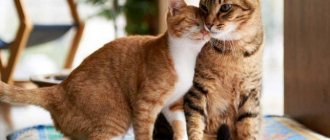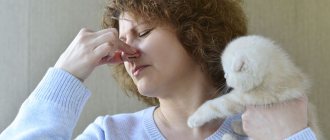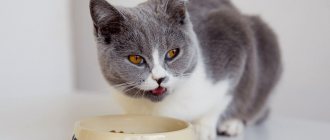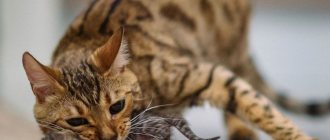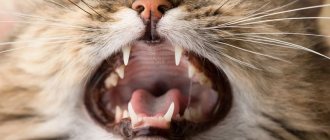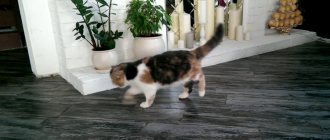Sometimes inexperienced owners are surprised: why does a cat twitch in its sleep? There is no need to panic, for animals it is as natural as for a person to talk in a dream. One cat twitches more often in its sleep, another almost never, this is very individual among cats.
Sometimes, inexperienced owners are surprised that the kitten twitches in its sleep, and may even make strange sounds: sometimes purr, sometimes “cry out.” This behavior during sleep is quite natural for animals; this is not at all an indication that the pet is sick with something.
Like people, our smaller brothers have certain sleep phases. At the same time, in cats, the duration of “deep” sleep is about a quarter of the total time spent in blissful slumber. And yet, why does this happen, why does a cat twitch in its sleep?
It may seem like cats are terrible lazy people, because they sleep most of the day, but in fact, this is not entirely true. What looks like sleep is often simply a state of relaxation, with the animal in control of everything that happens around it. Have you probably noticed that a “sleeping” cat opens one eye slightly as soon as some movement occurs?
So, when a cat decides to take a nap, she curls up, gets comfortable, and relaxes all her muscles. The shallow sleep phase begins, and after about 10-30 minutes it gives way to deep sleep.
During this period, the muscles are completely relaxed, the cat lies on its side. And then, when the animal is truly asleep, noticeable movements of the tail, ears, and limbs occur, and the cat twitches in its sleep.
A person, unlike cats, while in this phase of sleep, dreams. In this special state of the brain, information about recent events is transferred to deeper layers of memory from its “temporary” section. Cats probably experience similar experiences.
If a person has developed areas of the brain responsible for psycho-emotional experiences and imagination, then for less developed animals physical movements and motor skills are important. These are what the cat’s brain reproduces, while relaxed muscles sometimes reproduce by inertia.
Periods of deep sleep for cats are about 6-7 minutes. During a long rest there can be many such phases. Therefore, if your pet “talks” or moves in its sleep, do not rush to contact the veterinarian; this is quite normal.
Modern veterinary medicine quite successfully fights many infectious, viral, dermatological, senile and other diseases in cats, but in order to correctly prescribe treatment, it is necessary to take into account the entire complex of symptoms.
When cats can shake
Cats can tremble not only in their sleep, but also while awake. The main problem for the owner is determining the cause of the trembling and whether any disease is present.
If this phenomenon occurs quite often, it is necessary to determine the room temperature. If the room temperature is not comfortable for the pet, measures should be taken to provide warmth to the pet. The measure consists of raising the room temperature or providing the animal with warm bedding and eliminating drafts.
It is necessary to provide cats with warm bedding.
Sign that the cat is freezing
A sign that your pet is freezing can be the “curl” position adopted during sleep and a deeply hidden nose.
The cat hides its nose if it is cold.
Light twitching
According to available data and statistics, most cats regularly experience small twitches while sleeping. Some experts believe they may be similar to what people experience during REM eye movement sleep. During rapid eye movement, people dream and experience a deep sense of pleasure in sleep. Those little twitches your kitten or cat makes could be simple movements they make while chasing a mouse or playing with other cats in their dreams.
Sleep epilepsy or sleep disorder
How to distinguish between nocturnal seizures, are seizures a manifestation of epilepsy during sleep or is it a sleep disorder?
Differential diagnosis of paroxysmal events during sleep
To clarify the nature of nocturnal attacks, an objective research method is video EEG polysomnography. An option for diagnosing epilepsy in sleep is video EEG monitoring; studies are more informative after sleep deprivation.
If during a paroxysm epiactivity is simultaneously recorded on the EEG of sleep, then these paroxysms are of epileptic origin, that is, they are epileptic seizures in sleep.
Night attacks can be short and not accompanied by epileptiform EEG discharges; then these disorders of non-epileptic origin are more often classified as parasomnias.
Sleep disorders are often associated with certain stages of sleep and have a characteristic clinical picture.
At an appointment with an epileptologist, there are also options when the patient has nocturnal seizures and epilepsy, but this is not epilepsy.
Let us give a clinical example of seizures during sleep, accompanied by epileptiform activity on the EEG, but not related to epilepsy.
A 3-year-old boy came to see him with nocturnal paroxysms in the form of sleepwalking and sleep-talking. According to my mother: “2 hours after falling asleep, he gets out of bed, says, and walks around the apartment. It's like he's looking for something. More often than not, something is unclear. Some of the words can be understood; they are associated with sleep, with the events of the day. Sometimes the son laughs, cries, moans, is afraid, and is in a hurry. The eyes are open, but the gaze is unconscious or “wild”. After about 10 minutes I manage to calm him down and put him to bed. He falls asleep calmly. After treatment with sedatives, there was a break in his sleepwalking for 4 months, and then gradually became more frequent up to 2-4 times a month.” On the EEG, the patient has epiactivity of the type of benign epileptiform discharges of childhood in a small amount in the background and during sleep. When conducting an EEG with sleep deprivation: during sleep recording, neurophysiologists described a paroxysm (sat down on the bed, did not react, said a few words), but at this moment no epiactivity was noted in the EEG. A diagnosis was made: Parasomnias (sleeping, sleeping). Concomitant diagnosis: Benign epileptiform disorders of childhood. There are currently no data for active epilepsy. Antiepileptic drugs were never prescribed to this patient. Emphasis was placed on the need to maintain a rational daily routine. In therapy, he received sedatives or nootropics in age-related doses in the form of monotherapy (pantothenic acid, adaptol, atarax, phenibut, decoction of sedative herbs, novopassit) in courses of 1-2 months, 1-3 courses per year. The response to such therapy is always good: the parasomnias described above completely stopped for 4-8 months or decreased significantly; could be of an erased nature (sits on the bed in a dream, sits for 3-5 seconds, lies down and sleeps further; no more than 1-2 times a month). The child has been observed by an epileptologist for several years. Over time, complaints about sleep disturbances gradually become less and less. According to the EEG, epiactivity of the DERD type persists: in different recordings it may be in a small index or absent.
How to get a restful sleep
Useful tips to normalize sleep and get rid of involuntary body movements:
- you need to identify the cause of the disease and, if necessary, seek help from a specialist;
- take sedatives if there are no contraindications;
- beware of hypothermia;
- add foods rich in macronutrients to your diet;
- reduce consumption of tea and strong coffee;
- do exercises in the morning, take walks in the fresh air before going to bed;
- accustom yourself to go to bed and get up at the same time;
- choose a comfortable bed with orthopedic accessories.
These rules are useful only if a person twitches in his sleep and this does not affect the person’s sleep in any way and does not bring much discomfort. If you have serious illnesses, it is impossible to cope with the disorder on your own; it is better to seek help from a qualified specialist.
Twitching in sleep or sleeping myoclonus is a syndrome that is manifested by muscle contraction (also called positive myoclonus) or a decrease in their tone (negative) during the period of maximum possible relaxation. It is worth noting that twitching can affect both the body as a whole and its individual parts (usually the arms and legs).
The phenomenon of night twitching is common in both the adult population and the younger population, including infants. It is believed that about 70% of people twitch in their sleep. But most people don’t know about this, since myoclonus does not contribute to awakening and people don’t remember about it in the morning. Therefore, household members often pay attention to him and pester him with the question of why the person slept so restlessly at night.
There is also another definition for nocturnal twitching - hypnagogic twitching. It was first described by physiologists as a simultaneous tension of all nerves in a bundle directed to a particular muscle.
Motor activity during sleep of an adult cat
It is normal for a cat to twitch slightly during sleep once it has passed adolescence. Adaptation of an animal in the outside world and among “its own kind”, strengthening its nervous system, completing the construction of “owner-pet” relationships contributes to its psychological stability. The cat does not experience significant stress and therefore sleeps more peacefully.
In an adult, REM sleep is accompanied by:
- infrequent and not pronounced movements of the paws;
- twitching of the lip, mustache, ears;
- motor activity of the tail;
- rare screams, meows, growls.
If a cat older than two years old experiences emotions characteristic of a kitten in a dream, it is highly likely that it may be diagnosed with behavioral changes - increased nervousness, aggressiveness. It is difficult for such animals to adapt close to humans, and sometimes living together becomes impossible.
What causes seizures?
A cat twitches convulsively in its sleep due to the presence of an internal disease or a pathological process caused by parasites. The most common causes of seizures are:
- tumors;
- lymph inflammation;
- brain diseases;
- mental pathologies;
- deficiency of calcium or other substances;
- disturbances in the functions of the peripheral nervous system;
- infection by parasites and others.
When figuring out why cats twitch in their sleep, doctors identify specific diseases, including:
- non-purulent meningoencephalitis;
- cerebral ischemic encephalopathy;
- viral infectious peritonitis;
- toxoplasmosis;
- hyperparathyroidism;
- helminthiasis;
- ticks and fleas;
- excess medications or other drugs and additives in the blood;
- microstroke;
- lack of vitamin B;
- urolithiasis disease;
- renal failure;
- anemia.
Each of these diseases is very serious, but the most dangerous of them are meningoencephalitis, encephalopia and peritonitis.
Why does a person twitch in his sleep?
Experts have identified several types of night twitches, each of which has its own cause and a specific way of manifesting itself.
A fairly common syndrome that causes short-term spasm of a certain muscle group. This occurs due to uncoordinated muscle tone and a state of complete relaxation. When a person falls asleep, the brain perceives this as a possible state of death. Therefore, the body begins to receive impulses so that the brain makes sure that the person is alive.
If the nerve impulse fails to touch the muscles of the body, the brain sends the signal again, only with more powerful force. Having reached its goal, the impulse disrupts the calm and state of relaxation, thereby provoking involuntary twitching.
Sleep paralysis
Becomes active during the transition from the waking state to the stage of falling asleep. Hallucinations, panic, a feeling of fear, and rapid breathing may occur. Particularly susceptible people imagine otherworldly forces or the presence of intruders in the house.
Common causes of paralysis are disturbances in the day and night routine, severe shocks, stress and a sedentary lifestyle.
An equally common cause of nighttime tremors is “Ekbom's restless legs syndrome.” It is characterized by burning and severe pain in the foot and lower leg when falling asleep or during sleep. The result is an involuntary shaking of one or both legs, causing a sudden awakening.
The cat dreams of hunting or chasing
Scientists received the answer to the question of whether animals can see nightmares half a century ago. After conducting a series of cruel experiments, French biologists found that the brain of cats during the rest period works exactly like a human. Cats also have phases of shallow and deep sleep, when they, like their owners, “replay” the events of the past day in their heads to “rewrite” information from short-term memory to long-term memory. Moreover, as in humans, a certain part of the brain in tailed animals is specifically designed to constrain the animal’s muscles while it is dozing. When a malfunction occurs in its operation, the cat begins to move in its sleep. Why does this happen and is it dangerous?
With the development of brain research technologies, it has become clear that cats experience emotions akin to humans. Intense joy, fear or anger that arises in response to events occurring in a dream puts a strain on the animal’s nervous system, and it ceases to cope 100% with its safety “paralyzing” function. In a healthy cat, this is expressed by a slight twitching of the paws and tail. Usually, by the amplitude of the movements performed, you can understand what the pet is dreaming about: a chase, a hunt or a fight. This is often observed in kittens whose nervous system has not yet fully developed. For the same reason, babies under one and a half years old twitch much more intensely in their sleep than adult animals. There is no need to wake them up. Whatever the beast is dreaming of, suddenly brought back to reality can disorient it, but cannot calm it down. It's better to wait until the cat gets up on its own. If at the same time the animal shows concern under the impression of the dream, you can cheer it up with kind words or treat it with a tasty treat.
Physiological causes of trembling
Sometimes a cat trembles due to external factors such as a sudden change or decrease in the temperature of the surrounding area. Physiological factors of tremor also include stress, sexual arousal, deep sleep or some reflex processes in the animal’s body.
Cold
You will often notice that your cat will shiver after swimming or spending a long time outside on a cold day. This tremor is a mechanism of thermoregulation and does not allow the animal to freeze for a long period of time.
Pampered domestic cats get chills even with a slight drop in ambient temperature, while a pet hardened by frequent walks can stay outside for a long time, even in severe frosts. Owners should take into account such individual characteristics of their cats’ bodies to determine the duration of the walk, since hypothermia easily leads to the development of colds and inflammatory pathologies.
Important! Even if the room is warm, the animal's fur must be thoroughly dried after bathing. It is also important to ensure there are no drafts and not to allow the cat to lie on a cold surface.
Emotional excitement
The cat may tremble as if it were cold when there is strong emotional arousal, positive or negative. Both during fear and during times of great joy, a large amount of certain hormones enter the animal’s bloodstream, which provoke muscle tremors.
By this sign you can determine the mood of your pet. For example, when nervous, a cat shakes as if frozen, arches its back, hisses or meows loudly. Sometimes the readiness to attack is expressed only in the shaking of the tail raised up. At the same time, sitting on the lap of its beloved owner, the animal may tremble slightly and purr with pleasure.
Sexual arousal
During the period of sexual heat, all the senses of male cats become more acute. In the absence of a sexual partner, animals are constantly nervous, strive to get out of the house, and may show aggression or excessive intrusiveness. The cat is shaking from the powerful release of sex hormones into the blood. This condition leads not only to mental disorders of the animal, but also provokes the development of malignant tumors of the reproductive organs and mammary glands. Therefore, the most humane way to get rid of the suffering of cats and female cats that do not take part in breeding is castration.
Other reasons
Some cats may experience tremors as a reflex after eating food. It is especially common to notice how a well-fed kitten trembles in its sleep and does not show signs of anxiety.
Sometimes owners have a question about why the cat trembles when he sleeps. Experts even have a special term “sleepy tremor,” which indicates maximum relaxation of all muscles.
A cat may also shiver in its sleep when sleeping indoors with low air temperatures. This is indicated by the animal’s posture - the cat curls up into a tight ball, “burying” its nose as deeply as possible into the fur or under the paw.
Important! If the cat is shaking in its sleep, trying in vain to warm its frozen limbs, but at the same time the room is quite comfortable and warm, then you should measure the pet’s temperature. Her sharp decline indicates a very serious pathology that is life-threatening.
Poor and restless sleep, which is accompanied by periodic twitching of the limbs and tremors in the body, may be a consequence of stress or prolonged physical exertion. Most often, owners observe this condition in their pet after he “defended his rights” to a female during the period of sexual heat.
“Senile tremor” can also be considered normal. Poor circulation and innervation is the reason why an elderly cat shakes when lying or sitting in a relaxed state.
Complete relaxation
To help your pussy fall into deep sleep, where twitching may sometimes occur, provide him with a sleeping area that maintains a constant, comfortable temperature. Cats especially feel safe in high places, where they are protected from various stimuli, such as other animals in the house.
At temperatures below 20 degrees, a cat may curl up and hide its nose under its tail, but at higher temperatures, it will tend to gradually relax its position.
Noticing that a cat is twitching in its sleep, the owner may be concerned about the well-being of the pet. If we are talking about an adult cat, suspicions are far from unfounded. Let's figure out why cats twitch in their sleep and what it may indicate if a cat twitches too much.
It was cats, or rather, their dreams, that made it possible to prove to the whole world that animals also plunge into the world of dreams. Moreover, scientists suggest that our pets' dreams are much richer and more dynamic than ours.
It all started when doctors began to study the phases of human sleep. To confirm their assumption that healthy people lose the ability to move during REM sleep, an experiment was conducted on a group of cats.
All animals had a small area of the brain removed, which was responsible for muscle atonia in the REM phase of sleep. After the animals were fully rehabilitated, the scientists' suspicions were corrected. The observed cats stood on their paws, walked confidently, and turned their heads, as if watching someone. While in a state of sleep, cats sniffed and turned their ears. The experiment proved that cats see, hear and touch dreams.
This is interesting!
A healthy, adult animal does not move during REM sleep, although rapid eye movements and slight twitching are considered normal.
With the development of medical equipment, it was possible to prove that during dreams, cats experience real emotions: fear, joy, excitement, aggression. Near the animals under observation, “pheromones” of a same-sex cat were sprayed and the observed one showed aggression. In the opposite case, when the scent of an animal of the opposite sex was sprayed, the observed behaved calmly or interestedly. That is, animals not paralyzed by the REM phase not only sensed the outside world, but also made natural, instinctive decisions. These observations led to the conclusion that in their dreams, cats see themselves and their surroundings very realistically.
This is interesting!
Experiments were carried out on cats, dogs and rodents. Cats surprised scientists by very naturally emitting hunting in their dreams. The dogs unexpectedly hinted at the animal essence, imitating the behavior of wild wolves. The rodents broke all records, because even in their sleep they were able to solve the tasks assigned to them.
The study of human and animal sleep continues. Of course, today it is no longer practiced to remove part of the brain for the sake of observation. To relieve atonia during the REM phase, blockades of part of the brain are used. Modern scientists are on the verge of a big discovery, since the experiments included observations of brain activity using highly sensitive scanners. There is no doubt that cats dream, but perhaps we will soon find out exactly what their dream world looks like. Already today, scientists have managed to find out that kittens see their first dreams while still in the womb.
How to treat fever in a child who has previously had febrile seizures?
If the child does not have an increase in temperature during illness or after vaccination, it is not recommended to give antipyretic drugs! This does not reduce the risk of an attack.
If the temperature has risen, medications to reduce it make you feel better overall, but do not help with attacks.
The harm from anticonvulsants for the prevention of febrile seizures outweighs the benefits; they are almost never prescribed.
If a child’s febrile convulsions are prolonged, at the beginning of the attack it is recommended to administer a drug from the benzodiazepine group in the form of an enema, a spray in the nose or a gel on the cheek. Unfortunately, none of these forms are registered in Russia. Therefore, if an attack lasts longer than 5 minutes, an emergency doctor may give an injection of such a medicine.
For antipyretic drugs, children can be given ibuprofen at a dose of 10 mg/kg every 8 hours or paracetamol at a dose of 15 mg/kg every 6 hours. Don't give children aspirin!
Signs of imminent death
You can know that a cat is dying by the presence of a combination of certain symptoms. If your pet is over 12–14 years old, then you need to carefully monitor its behavior and health. Some felines live up to 25 years, but this happens very rarely.
Before you prepare for the worst, you should take him to the vet. It is likely that the pet is simply seriously ill, but it can be cured. Timely therapy is important for recovery, so do not delay going to the clinic or calling a specialist at home. For example, older cats often develop chronic pathologies that are similar to signs of impending death. However, if remission is achieved, the animal can live several more years without suffering or pain.
But even if medical intervention does not help, the doctor will advise how to properly care for your friend and prescribe medications to relieve symptoms. If you don’t have enough time to carry out supporting manipulations yourself, the cat can be placed in a clinic where he will be provided with the necessary care.
Loss of appetite is an alarming symptom
A cat's eating behavior changes dramatically before death. She eats little or refuses food at all, and then even water. The following signs should alert you:
- untouched food in a bowl;
- absence of excrement in the tray for two or more days;
- feces containing blood;
- darkening of urine.
After some time, hunger makes itself felt with sunken sides and physical exhaustion. The hair begins to fall out, the pet is no longer active and constantly lies down. Due to weakness, control over the muscles of the intestines and urinary tract is reduced. There may be traces of feces left on the floors of your home.
Difficulty breathing is a sign of the approaching end
Other symptoms of a cat dying are changes in breathing. The heart can no longer work fully, so the amount of oxygen entering the lungs and blood decreases. The pet draws in air heavily and rapidly, trying to make up for the losses. In a healthy animal, the frequency of breaths per minute is 20–30. Shortness of breath, weak or infrequent breathing are symptoms of imminent death. It is not difficult to determine the indicator; just use a stopwatch and count the number of chest rises per minute.
Decreased heart rate and blood pressure are dangerous symptoms
Signs that a cat is dying include a slowing heart rate (normally 140–122 beats per minute) and a decrease in blood pressure. Changes in these indicators occur due to difficulties in pumping blood by the heart and, as a result, overload. You can measure an animal's pulse like this:
- place your palm on the left side behind the front paw;
- count the number of beats in 15 seconds;
- calculate the heart rate per minute by multiplying the resulting figure by 4. If the number of beats is less than 60, then this sign indicates the cat’s approaching death.
Unfortunately, it is impossible to measure your pet’s blood pressure at home without special equipment.
shutterstock
A specific smell is a sign of imminent death
A dying cat emits an unpleasant odor. This happens due to a decrease in the performance of internal organs. The elimination of toxins slows down or completely stops. Harmful substances gradually accumulate in the body, a symptom of which is the unpleasant aroma of the animal’s body and mouth.
Reduced temperature
When checking for signs of death in a cat, be sure to measure its body temperature:
- a special ear thermometer;
- a rectal digital device, the tip of which is carefully inserted into the rectum.
The body temperature of a dying cat is significantly lower than 37.7 ⁰C, which indicates a weak heart. When you don’t have a thermometer at hand, you can feel the animal’s paw pads. If they are cool, then this is also a bad symptom.
Factors
- Another possible factor for tremors in a cat may be uncomfortable posture . Cat muscles and joints are capable of reacting this way to being in an uncomfortable position for a long time.
- An equally significant fact can be stress or previously experienced fear . A possible reason is the animal’s excessive activity during hunting and games. As well as the presence of injury or bruise.
The fact that a cat is trembling may be due to stress.
The importance of REM sleep in kittens
Kittens are able to dream while still inside the mother cat. Moreover, REM sleep provides neural stimulation, which contributes to the normal development of the brain and the entire nervous system of the embryo. The REM phase is extremely important for newborns and growing animals. Young animals experience dreams especially vividly. Kitty:
- can move its paws;
- beat the tail on the floor;
- roll over from side to side;
- move your ears and cheek muscles;
- breathe rapidly and meow.
Especially often, such violent reactions appear after outdoor games, stress or hunting experience. Running and tired, the baby may fall asleep in an unnatural position with his eyes half-open, which also should not cause concern. Firstly, kittens are like human babies and relax in their sleep without feeling discomfort, and secondly, the presence of a third eyelid in the corner of the eye helps protect the eyeball from drying out.
Features of the nervous system in kittens. The nervous system is formed simultaneously with the growth of the body, so unusual motor activity in kittens in the REM phase is completely normal.
If in adult animals the duration of REM sleep is 15-20 minutes, followed by a longer phase of slow-wave sleep, then in kittens up to six months the REM phase takes up 80% of the total rest time.
If the owner noted that the growing furry pet began to sleep more calmly and practically does not flinch in its sleep, then we can talk about the animal growing up and strengthening the nervous system. The period of stabilization of nervous functions is very individual and is determined by many factors, such as:
- Breed affiliation. In outbred cats, which generally mature faster, psychological maturation begins by 12 months, and representatives of large breeds, growing up to 2-2.5 years, demonstrate elements of childish behavior for quite a long time.
- Character. Temperamental and easily excitable animals require more time for the development of nervous processes than balanced and calm phlegmatic animals.
- Personal negative experiences and traumas. Stress can cause serious damage to the psyche. It has been proven that animals that have experienced fear and pain can return to this episode in their sleep, experiencing real nightmares.
Also watch the video why a cat twitches in its sleep:
Emotional excitement
What to do if your cat is shaking? First you need to find out the reason, and only then take some action. For example, periodic trembling in an animal may appear due to certain emotional states. For example, the cat experienced severe fear, discomfort from the appearance of strangers in the apartment, and aggression arose.
Note that not only negative emotions can cause such conditions in a pet. For example, a cat that is experiencing bliss may also tremble periodically. Some owners notice that when they return after work and the cat is bored, rubs, purrs, and literally shakes with joy. This is the normal state of the animal. Therefore, you should not leave your pet for a long time if it is so hard for you to be separated from you.
Symptoms of seizures
Many people are probably familiar with the sensation that is caused by a muscle cramp, and at the same time there is a sharp pain. Cats experience similar sensations with muscle cramps. Visually, chaotic movements made by the paws are visible. Sometimes the opposite happens, and the pet lies on its side with tense paws curled under its stomach and clenched fingers.
The cat at this moment is very scared, screaming in pain, but does not allow the owner to touch him. During moments of convulsions, the cat’s pupils are dilated, and the whiskers are pressed tightly to the muzzle or become bristling.
If there are cramps in the hind legs, the pet may fall and the legs may be pulled in length. During a seizure, the cat may try to get up, but he will not be able to do it. But that rarely happens. Most often he is afraid to even move. In the most severe cases, the cat may urinate voluntarily and foam from the mouth. The animal does not recognize the owner, and therefore does not respond to his call. Sometimes the cat behaves aggressively.
But when the convulsions end, the pet, having calmed down, will behave as before. Although in some cases, for a short period of time, he may not find his usual places and may not even recognize his home.
Unfortunately, there are owners who, seeing their pet in this condition for the first time, do not rush to seek help from a skilled veterinarian, but wait until the seizures recur. This behavior is irresponsible, since seizures may indicate that the cat has developed a serious, and often life-threatening, illness, and when repeated seizures occur, time may already be lost.
It is very important not to make this mistake and bring your pet to the veterinarian even if after an attack of seizures he looks healthy and as cheerful as always. Seizures in cats vary and may be accompanied by additional signs in different situations.
Seizures in cats vary and may be accompanied by additional symptoms in different situations.
Your pet has seizures and twitching hind legs
Such convulsions occur in cases where there is a lack of a substance in the cat’s body or an excess of it. Similar conditions, with the exception of poisoning, for example, with pesticides, most often occur in elderly, pregnant, lactating, or malnourished animals. In more rare cases, such seizures may signal a stroke.
Cramps and drooling
Convulsions, which also cause drooling, may indicate the most terrible diagnosis for a cat - rabies. It is impossible to save a cat if it is already sick. He is immediately quarantined and restricted from any contact. In addition to cramps and drooling, it is necessary to carefully monitor other signs indicating the occurrence of the disease.
Cramps and foam at the mouth
Convulsions in a cat, accompanied by foam from the mouth, occur during an attack of epilepsy. But there are other reasons for this condition - kidney and liver diseases, hepatic encephalopathy, endotoxicosis, hypoglycemia.
Seizures of epilepsy with convulsions and foam at the mouth may indicate brain tumors, ischemic encephalopathy, and rarely post-traumatic or post-infarction conditions.
Cramps in a cat's hind legs while sleeping
Sometimes a cat has convulsions in his sleep. They can scare its owner. The pet is sleeping, but its eyelids, whiskers and lips are twitching, its paws, both front and back, tremble finely and often. You can hear the cat's loud meow or purr. In most cases
Such convulsions in a cat’s sleep are only a sign that he is having exciting dreams. But if he suddenly jumps up at the moment of convulsions during sleep, looks around restlessly, and then for a long time he cannot find a place for himself, then you need to sound the alarm and take the cat to the veterinarian.
Convulsions in a cat before death
In many cases, in cats, like in any other animal, the death throes are accompanied by convulsions. This condition may indicate approaching clinical death. Unfortunately, even if the course of treatment is carried out correctly, many diseases that are accompanied by seizures lead to the death of the cat. Therefore, if the veterinarian claims that your pet no longer has a single chance of recovery, you should not wait for the onset of painful and prolonged death throes. It is better not to cause him unnecessary suffering and, although it is very painful for the owner, to euthanize the animal.
Pathologies
It is necessary to diagnose the pathology in time.
Tremor can accompany the development of pathologies, so owners should closely monitor their pet and seek advice from a specialist.
Possible pathologies:
- cat flu;
- panleukopenia;
- rhinotracheitis;
- calicivirus;
- central nervous system disorder;
- kidney damage.
It is necessary to diagnose a possible pathology in time and take all measures to eliminate it.
The body is a single whole
There are also explanations for why the body twitches in a dream. When the body is asleep and not controlled by its rational part, it often senses its needs much better, for example, a lack of vitamins, potassium or calcium. However, in this case, you should definitely seek advice from a specialist, and not prescribe yourself self-medication, consuming all kinds of vitamins and mountains of microelements, which can cause harm.
Also, if your legs twitch when falling asleep, you can suspect problems with the blood supply to the extremities. If a person suffers from vascular pathology, then such involuntary movements help blood flow to the most distant areas. By the way, for this reason, many girls can clearly observe twitching associated with monthly blood loss.
But if muscles twitch throughout the body, the cause may be a short-term cessation of breathing during sleep. This most often affects people prone to snoring. Improper breathing provokes the very delays to which the brain sends an active nerve impulse.
And finally, myoclonus associated with acute or chronic stress. When a person seems unable to stop running and continues to run. Often, he also tends to talk in his sleep and even fight.
Treatment of trigeminal neuralgia
Treatment is aimed at:
Read also: The Mystery of the Bermuda Triangle
- to eliminate the cause of damage;
- to alleviate the patient's condition;
- to stimulate the restoration of nerve structures;
- to reduce the excitability of trigger zones.
Properly selected treatment can reduce the frequency, intensity and duration of pain waves, and ideally achieve stable remission.
Drug treatment
Trigeminal neuralgia requires complex treatment using drugs from several groups:
- anticonvulsants (carbamazepine and analogues): reduce the excitability of nerve fibers;
- muscle relaxants (baclofen, mydocalm): reduce muscle spasms, improve blood circulation, reduce pain;
- B vitamins (neuromultivit, milgamma): stimulate the restoration of nerve fibers, have an antidepressant effect;
- antihistamines (diphenhydramine): enhance the effect of anticonvulsants;
- sedatives and antidepressants (glycine, aminazine): stabilize the patient’s emotional state.
For severe pain, narcotic analgesics may be prescribed. Previously, drug blockades (injecting the problem area with anesthetics) were actively used, but today this method of treatment is almost never used. It contributes to additional damage to nerve fibers.
They're too cold
While cats are good at regulating their body temperature , they may still feel cold. Being too cold is a possible reason why your cat twitches when they sleep. Cats have a higher body temperature than humans, around 39°C/102°F. On particularly cold days or winter nights, cats often feel the cold in their small bodies.
In such cases, the cat may even look for you to sleep next to you. By sleeping next to you, they can share your body heat and feel warmer. Some cats may be more prone to cold, especially hairless cats.

